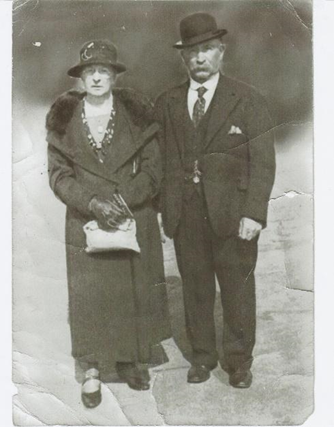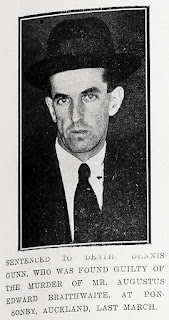A man called into the Water Police station Sunday 10 October 1887 to report a fatal boat accident which had taken place near the Hobsonville Wharf the evening before.
Nicholas Hand was the sole survivor, having been able to swim ashore after the boat capsized. He advised the Police that Alexander Lynch and Sarah Thornton had drowned and that the body of Sarah had been recovered, and was lying on the Hobsonville Wharf.
Under direction of Sergeant A. Clark, the Water Police boat was launched and the dead body of the woman located, and placed in their boat.
They also searched the beach for the body of Alexander Lynch, but failed to find any trace of him.
The body of Sarah Thornton was brought to the morgue pending an inquest, and several witnesses were also brought to town.
Hand was interviewed and gave an account of the previous evening.
He told the Police that a party including himself, Alexander Lynch, Sarah Thornton, and a man named James Williams, left the Queen Street Wharf at 4 p.m. on Saturday, bound for Riverhead where they intended to go gumdigging.
The boat was a small open keel and about 13 feet long. They had food supplies on board and also alcohol, although Hand added that they were all fit to sail.
They reached Hobsonville Wharf about 6 p.m, and Williams got off the boat there.
A short time later, a sudden squall caused the boat to gibe, and being very low in the water she quickly filled with water. Hand, Thornton and Lynch were thrown into the water. When Hand came to the surface, the sail was on top of him and when he got out from under the sail, he found Lynch and Sarah Thornton holding on to the boat.
Both Lynch and Hand were able to swim, but it was not known whether Sarah could swim or not. The men succeeded in righting the boat and put Sarah inside, but the sail was still up and the boat capsized again. The men got the boat steadied, only to be overturned again and all three were once more thrown into the water. At last they succeeded in righting the boat once more, and put Sarah inside, and with Lynch on one side and Hand on the other, they started swimming with her towards the shore. Not long after, Sarah leaned too heavily on one gunwale and the boat capsized again, leaving the three in the water again. Several more attempts to right the boat and keep it upright failed, and it was decided by Lynch that they should abandon the boat and swim for the Shore.
Lynch called out for help several times, but heard no response, there was no other boat in sight.
Lynch and Hand told Sarah to place her hands on their shoulders and they would swim ashore, one on each side of her. She did so, being at this time extremely exhausted and unable to support herself.
They proceeded this way towards the Shore, but then Lynch’s tiredness overcame him, and he began sinking in the water. He pushed the woman towards Hand who continued to do the best he could with the woman, but had to leave Lynch behind. A desperate Sarah clutched Hand with both arms causing them to sink together. He tried to loosen Sarah’s grasp on him, but he was exhausted himself, and when she kept him under water longer than he could stand, he gave her a shove, and she floated a few yards ahead. She managed to keep herself afloat, and Hand tried to recover a little strength. He tried again to assist Sarah towards the shore, but had to leave her, his energy was spent.
Hand then saw Williams on the Wharf and kept swimming until he could tread the nearby mudbank, and as soon as his feet found firm ground, a boat containing two young men came alongside and picked him up. They then returned for Sarah who had drowned.
By this time a crowd of people had gathered, and Hand was advised to remain at Hobsonville that night, and inform the police of the accident the following day. He remained with the two young men who had picked me up and obtained from them some dry clothes.
Two young men named McLeod came down from Hobsonville to give evidence at the inquest. They stated that they saw the boat containing Lynch, Hand and Sarah Thornton capsize, and launched a small boat to proceed to their rescue as speedily as possible. They had however to convey the boat over the beach for some considerable distance, and were unable to render much assistance beyond picking up the dead woman.
Sarah Thornton was a married woman, 33 years of age who was discharged from Mount Eden Jail on Saturday, having been on many occasions convicted of drunkenness.
Sarah was the wife of a scenic artist who was also well known as an actor. At the time of the accident and inquest, Mr Thornton and their daughters were on a tour in Australia.
Sergeant Clark advised that Sarah Thornton was well known to the Police, and had just been released from Jail from a month's sentence for habitual drunkenness. He received information of the drowning at half past twelve on Sunday morning from the witness Hand and went up to Hobsonville to retrieve the body as described. They could find no trace of Lynch's body, or of the boat, and from his knowledge of that part of the harbour, a sudden gust of wind could easily account for the upsetting of the boat.
Without retiring the jury returned a verdict of accidentally drowned.
Some weeks later the decomposed body of a man was found on the beach near Lucas' Creek. This was identified as Alexander Lynch and was taken to the mortuary. As all the facts of his death were related to the recent inquiry it was not considered that an inquest would be required.
Alexander Lynch was also a noted character. He was a single man aged about 53 years of age and lived at Riverhead. He had also been a “guest” of arrangements of Mount Eden Jail.
Anglican Division C, Row 3,
Plot 41: Sarah Thornton (35) 1887 – Domestic – unmarked grave
Sources Papers Past Evening Post Volume XXXIV issue 87 10/10/1887
Auckland Star volume XV111 issue 238 10/10/1887
Compiled by Susan Reid, Discover Waikumete


























